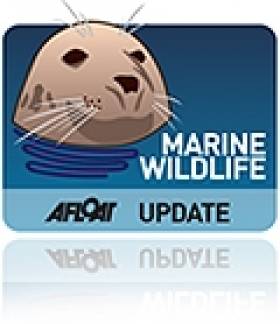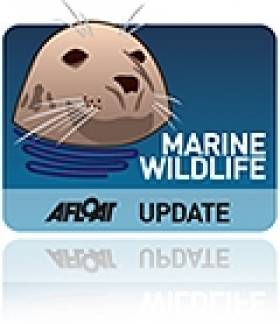Displaying items by tag: Jellyfish
Lions Mane Jellyfish Arrives into Dublin Bay
#jellyfish – The CEO of Irish Water Safety, John leech is urging the public to use the Local Authority manned lifeguarded bathing places to ensure that they avoid being stung by two of the most venomous jellyfish that visit our waters. The Lions mane Jellyfish has been spotted in Sutton.
The Lifeguards ensure your safety on our beaches and will be patrolling on their surf rescue boards and on the beaches to ensure that they do not pose a threat to members of the public.
The CEO is also alerting the public that due to the high temperatures in our waters, the prevailing westerly winds and the north Atlantic current, these potentially dangerous jellyfish are likely to appear on more of our beaches in the coming weeks. The Portuguese man o 'war jelly fish was reported on Bunmahon and Clonea strand in Waterford last Tuesday.
Earlier today in Barleycove, West Cork, a young girl was rushed to hospital after suffering an apparent allergic reaction to a sting from a Jellyfish.
Jellyfish Pose Threat To Irish Beachgoers
#MarineWildlife - As if this week's warnings against swimming at 12 North Co Dublin beaches weren't enough, The Irish Times brings news of sightings of the dreaded Portuguese man o'war among other stinging sea creatures flocking to Ireland's warmer waters.
As reported earlier this week on Afloat.ie, Irish Water Safety chief John Leech gave warning of sightings at Bunmahon and Clonea strand in Waterford of the dangerous jellyfish-like species, last seen here in big numbers in September 2012.
But the warm currents flowing towards Irish shores are also likely to bring the lion's mane jellyfish, which packs a sting to match its large size - often 2 metres in diameter.
The Irish Times has more on the story HERE.
#Jellyfish - A giant jellyfish found beached on Dorset's south coast in recent days could be a harbinger of a future invasion of British and Irish waters.
ITV News reports on the metre-wide barrel jellyfish, also appropriately known as the dustbin-lid jellyfish, which was found by a dog-walker on Portland beach.
Despite its fearsome size, the UK's Marine Conservation Society says the Atlantic-native species is harmless to humans.
But warming waters off the UK and Ireland's southern coasts this summer could see them turn out in huge numbers, thriving in a climate that threatens our native marine species, as previously reported on Afloat.ie.
Jellyfish On The Rise As Ireland's Waters Warm
#Jellyfish - Jellyfish are coming to Ireland's shores in bigger numbers than ever before, as the Belfast Telegraph reports.
The "worrying" finding comes with the latest figures of the annual Coastwatch survey of the island of Ireland that concluded in mid October.
Stats collected from volunteers around the coast show that jellyfish have been sighted in more areas and in greater numbers than any other time in the 25-year history of the survey - most likely the result of climate change.
Among them was an "absolutely enormous" specimen more 5 feet in diameter, found on the West coast.
"What this says to us is that our waters are warming," said Coastwatch International co-ordinator Karin Dubsky, who highlighted an explosion in the numbers of small brown jellyfish "which do a lot of damage to wildlife".
The Belfast Telegraph has more on the story HERE.
Diver Stung In Face By Jellyfish Off Skerries
#Jellyfish - In less welcome jellyfish news, the Irish Independent reports that a female diver was airlifted to hospital after being stung in the face by a jellyfish off Skerries at the weekend.
The injured woman had been diving yesterday morning (1 September) in shallow waters off the North Co Dublin town with a party of five, three of whom raised the alarm when they lost sight of the other two.
Skerries RNLI were requested to launch by the Dublin Coast Guard, and after a short time searching they located the missing divers on the shore at a local swimming spot called the Springers.
The lifeboat crew found one of the women was in need of urgent medical assistance, suffering from severe hypothermia and jellyfish stings to the face.
Medical transfer to Our Lady of Lourdes Hospital in Drogheda was decided as the best option, and the casualty was soon airlifted from nearby Red Island on board the Irish Coast Guard helicopter Rescue 116.
Speaking after the call-out, Skerries RNLI volunteer lifeboat press officer Gerry Canning said: "This was a perfect example of how well our volunteers and all the other emergency services work together to ensure that casualties get the best possible care and in the quickest possible time."
Freshwater Jellyfish Discovered In Lough Derg
#Jellyfish - One angler's disbelieving discovery in Lough Derg has led to a surprise new marine wildlife find for Ireland's inland waterways.
Pat Joyce from Caslteconnell in Limerick nearly fell off his fishing stand when, in early August, he spotted what looked like a single small jellyfish pulsing in the water in front of him.
The jellyfish disappeared and Joyce thought that perhaps he was mistaken since, as everyone knows, 'there is no such thing as a freshwater jellyfish'.
Two weeks later, again angling for bream in the tranquil surrounds of Scarriff Harbour, just off Lough Derg, Joyce noticed not one but hundreds of tiny jellyfish moving on and below the surface.
He immediately contacted the Environment Protection Agency (EPA) to seek clarity, and they put him on to Inland Fisheries Ireland (IFI). Staff from the Clare region of IFI’s Shannon River Basin District sped to the scene and collected up to 20 live specimens. They really did exist!
IFI’s Colum Walsh and Dave Germaine contacted Dr Joe Caffrey, invasive species specialist with IFI, who immediately organised a site visit to Lough Derg with a team of marine science experts. These included Dr Tom Doyle, a jellyfish expert from the Coastal & Marine Research Centre in UCC, and Dr Dan Minchin from the Lough Derg Science Group.
The survey revealed small numbers of the jellyfish at Scarriff Harbour, but specimens were also recorded from two other locations within the lake – at Rossmore Harbour and at Dromineer.
So what is this jellyfish, where did it come from and why was it never spotted in Ireland before?
As soon as specimens were collected IFI forwarded them to Dr Doyle, who identification them as the free-swimming life stage of a species called Craspedacusta sowerbii. This marks the the first official record for this species in Ireland.
This freshwater jellyfish hails from the Yangtze River Valley in China but currently has a worldwide distribution. It was initially discovered in exotic aquatic plant tanks in Regent’s Park, London in 1880 but has since spread to widely throughout the globe.
The jellyfish is about the size of a euro coin and broadly resemble their marine cousins. It is more or less transparent with a distinctive white/greenish cross and a white/cream circular outline, and possesses in the region of 250–300 small tentacles.
These jellyfish have two distinct life stages; one is a tiny attached polyp and the second is what we know as the jellyfish or medusa stage. The polyp buds off medusa under warm water conditions, generally when water temperature reaches 25 degrees centigrade.
The species is known to occur in single sexed populations, and Dr Doyle confirmed that all of the specimens he examined from Lough Derg were female.
It is probable that the discovery of this jellyfish relates to the wonderfully warm summer that we experienced in Ireland this year, when water temperatures in many watercourses exceeded 25 degrees for prolonged periods. This probably stimulated the budding off of the medusae or jellyfish, which pulsed in the warm water in search of plankton prey. It is noteworthy that jellyfish were also reported from Lough Erne in recent days.
Experience in other countries suggests that blooms of such freshwater jellyfish occur only sporadically and that they last, in any one year, for only a few weeks. So it is possible that we may not see such a sight again for many years.
It is important to state that the freshwater jellyfish is not harmful to humans and that, while they do capture their tiny prey by stinging, the stinging cells are not sufficiently powerful to harm humans.
In addition, the jellyfish do not appear to have any significant effect on the biology or ecology of the waters they are recorded in, probably due to their sporadic occurrence and the short period that the jellyfish blooms are in any water body.
"Anglers are the eyes and ears on our rivers and lakes," said Minister of State Fergus O'Dowd following this amazing discovery. "I ask all anglers to continue to assist in the protection and conservation of this resource, reporting any invasive species they come across to the IFI Hotline immediately."
One serious cause for concern relates to the pathway whereby this jellyfish - and many other non-native and potentially harmful or invasive species - was introduced to Ireland.
The fact that the two watercourses from which the jellyfish was recently recorded (Loughs Derg and Erne) are both internationally renowned navigation waterways suggests that boating and perhaps ballast water from newly introduced craft may represent an important causative agent.
Boats and cruisers are commonly imported from abroad and are introduced into our waters without having to prove that they were cleaned and disinfected before leaving their country of origin.
“This practice is unacceptable and poses a significant threat to biodiversity in our waters and to their functionality, be it as recreational, amenity or municipal waters," said Dr Caffrey. "It is imperative that boats being imported into this country carry certificates of disinfection prior to being granted entry if we are to stop the ever-increasing spread of harmful invasive species.”
If you spot jellyfish in your local watercourse, please contact Inland Fisheries Ireland via www.fisheriesireland.ie or on the 24-hour hotline 1850 34 74 24. See also the EcoJel project at www.jellyfish.ie and the website of the National Biodiversity Data Centre.
Portuguese Man-of-Wars Arrive on Irish Shores
#WATER SAFETY - Irish Water Safety is warning members of the public that Portuguese Man-of-Wars have landed on beaches in Waterford and Cork, with reports of sightings in Tramore, Ardmore, Inchydoney and Schull so far – and may land on other shores, particularly Kerry
With another sunny weekend expected, surfers and families enjoying the beach are at a high risk of encountering them and their stings, which usually cause severe pain to humans.
The Portuguese Man-of-War is an invertebrate and carnivore with tentacles that can reach up to 50 metres in length. Despite being commonly thought to be a jellyfish, it is actually a different form of marine wildlife known as a siphonophore: an animal made up of a colony of organisms working together.
Man-of-wars are sometimes found in groups of 1,000 or more, floating in warm waters throughout the world's oceans. They have no independent means of propulsion and either drift on the currents or catch the wind with their gas-filled floats. To avoid threats on the surface, they can deflate their air bags and briefly submerge.
They are most commonly found in the tropical and subtropical regions of the Pacific and Indian oceans and in the northern Atlantic Gulf Stream.
The stinging, venom-filled nematocysts in their tentacles are used to paralyse small fish and other prey. Stings leave whip-like, red welts on the skin that normally last two or three days after the initial sting, though the pain should subside after about an hour.
However, the venom can sometimes travel to the lymph nodes and may cause a more intense pain. A sting can also lead to an allergic reaction and other serious effects, including fever, shock, and interference with heart and lung function. Stings in some cases have been known to cause death, although this is extremely rare.
Medical attention may be necessary, especially if pain persists or is intense, there is an extreme reaction, the rash worsens, a feeling of overall illness develops, a red streak develops between swollen lymph nodes and the sting, or either area becomes red, warm and tender.
Even detached tentacles and dead specimens (including those that wash up on shore) can sting just as painfully as the live creature in the water and may remain potent for hours or even days after the death of the creature or the detachment of the tentacle, so should always be avoided.
The best treatment for a Portuguese Man-of-War sting is to avoid any further contact with the creature, carefully remove any remnants of it from the skin (taking care not to touch them directly with fingers or any other part of the skin to avoid secondary stinging), Apply salt water to the affected area (not fresh water, which tends to make the affected area worse) then follow up with the application of hot water (around 45 degrees C) to the affected area, which eases the pain of a sting by denaturing the toxins.
If eyes have been affected, to irrigate with copious amounts of room temperature tap water for at least 15 minutes, and if vision blurs or the eyes continue to tear, hurt, swell, or show light sensitivity after irrigating, or there is any concern, to see a doctor as soon as possible.
Vinegar is not recommended for treating stings, as it can increase toxin delivery and worsens symptoms of stings from this species. Vinegar has also been confirmed to provoke hemorrhaging when used on the less severe stings of nematocysts of smaller species.
For more details from Irish Water Safety on dealing with jellyfish stings, click HERE.
Michael Viney writes in The Irish Times on growing concerns over lion's mane jellyfish and other harmful species in Irish waters.
The lion's mane is among the largest jellies found in Ireland and comes with a powerful sting, enough to disrupt "the stoical bliss normal to Dublin's Forty Foot bathing cove".
"Last year, the jellyfish was even more abundant in the Irish Sea than in 2009, and sightings from ferries found them from coast to coast," says Viney, who notes their and other jellies' dangerous effects on the marine industry and ocean ecosystems.
The decline of certain plankton-feeding species such as herring due to overfishing, coupled with a rise in sea temperature, has led to a marked increase of jellyfish of many different species in our waters such as the mauve stinger, which is blamed for decimating a Co Antrim fish farm's entire salmon stock.
The Irish Times has more on the story HERE.





































































